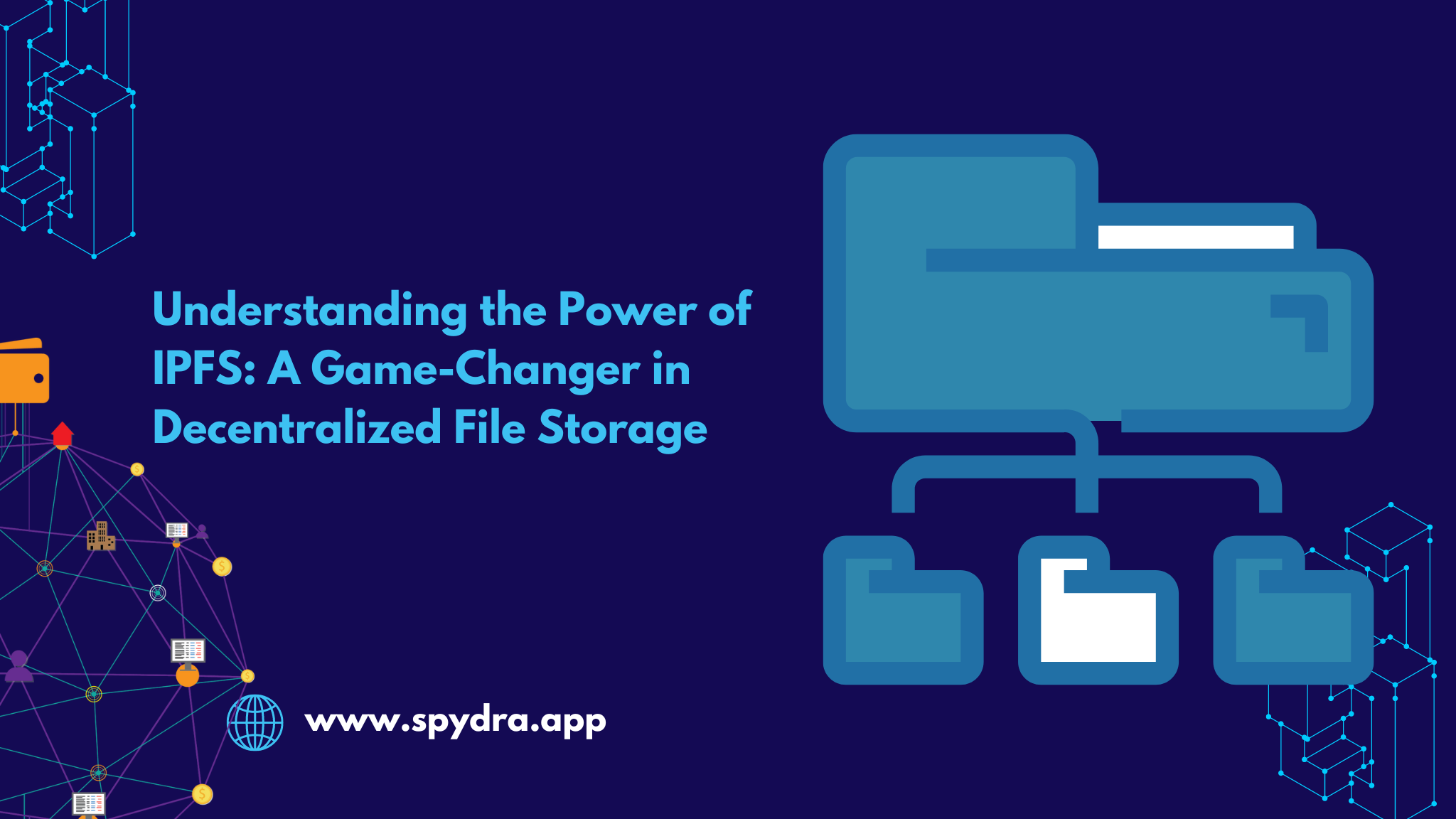Understanding the Power of IPFS: A Game-Changer in Decentralized File Storage
 Pravin
Pravin
Introduction to IPFS
In the ever-evolving digital landscape, the way we store, access, and share information has undergone a profound transformation. One innovative technology that has emerged as a game-changer in this realm is the Interplanetary File System (IPFS). IPFS is a decentralized, peer-to-peer protocol that aims to revolutionize the way we think about file storage and distribution.
Imagine a world where data is no longer confined to centralized servers, vulnerable to censorship, single points of failure, and data breaches. IPFS offers a paradigm shift, empowering users to take control of their digital assets and collaborate in a truly decentralized manner. By harnessing the power of distributed networks, IPFS promises to unlock new possibilities in the realms of data storage, content delivery, and the development of decentralized applications (dApps).
In this comprehensive article, we will delve into the intricacies of IPFS, exploring its underlying principles, advantages, use cases, and the broader implications it holds for the future of the internet and beyond.
How IPFS Works
At the core of IPFS is a unique approach to file storage and retrieval. Unlike traditional centralized file storage systems, IPFS utilizes a content-addressable, peer-to-peer network to store and distribute data. Instead of relying on a single server or a centralized repository, IPFS leverages a distributed network of nodes, each contributing a portion of their storage and computing resources.
When a file is added to the IPFS network, it is broken down into smaller chunks, each with a unique cryptographic hash. These chunks are then distributed across the network, with each node storing a portion of the file. To retrieve a file, the IPFS network uses the file's unique hash to locate and assemble the necessary chunks, delivering the complete file to the user.
This decentralized approach offers several key advantages:
Redundancy and Resilience: With data distributed across multiple nodes, IPFS provides a high level of redundancy, ensuring that files remain accessible even if individual nodes go offline or experience failures.
Faster Content Delivery: By leveraging the closest available nodes to serve content, IPFS can deliver files more quickly and efficiently, reducing latency and improving user experience.
Censorship Resistance: IPFS's decentralized nature makes it highly resistant to censorship, as there is no single point of control or failure that can be targeted to restrict access to content.
Bandwidth Efficiency: IPFS minimizes bandwidth usage by allowing nodes to share and cache content, reducing the need for repeated downloads of the same data.
Advantages of IPFS over Traditional File Storage Systems
IPFS stands out from traditional file storage systems in several key ways:
Decentralization: Unlike centralized file storage solutions, IPFS is a decentralized network, eliminating the need for a single point of control or failure.
Scalability: IPFS's peer-to-peer architecture allows the network to scale more efficiently, accommodating growing amounts of data and user demand.
Cost Savings: By leveraging the storage and bandwidth resources of its network participants, IPFS can offer more cost-effective file storage and distribution solutions compared to traditional cloud-based services.
Versioning and Immutability: IPFS's content-addressable approach ensures that files are immutable, allowing for seamless versioning and tracking of changes over time.
Offline Accessibility: IPFS enables offline access to files, as nodes can retrieve content directly from other peers without the need for a central server.
Censorship Resistance: IPFS's decentralized nature makes it highly resistant to censorship, ensuring that content remains accessible even in the face of attempts to restrict it.
Use Cases for IPFS
The versatility of IPFS extends to a wide range of applications and industries. Some of the key use cases for this innovative technology include:
Decentralized Web and dApps: IPFS is a natural fit for the development of decentralized web applications (dApps) and decentralized content platforms, where the need for secure and censorship-resistant data storage is paramount.
Digital Asset Management: IPFS can be leveraged for the storage and distribution of digital assets, such as art, music, and other media, providing a secure and transparent platform for creators and collectors.
Supply Chain Tracking: IPFS can be used to create immutable, tamper-proof records of supply chain data, improving transparency and traceability throughout the supply chain ecosystem.
Distributed File Sharing: IPFS offers a decentralized alternative to traditional file-sharing platforms, enabling users to share and access files without relying on a central server.
Decentralized Storage for IoT Devices: IPFS can be integrated with Internet of Things (IoT) devices, providing a decentralized storage solution for the vast amounts of data generated by these connected devices.
Decentralized Social Media: IPFS can power the development of decentralized social media platforms, where users have greater control over their data and privacy.
IPFS and Decentralized Applications (dApps)
IPFS and decentralized applications (dApps) are a natural fit, as the decentralized nature of IPFS aligns perfectly with the principles of dApp development. By leveraging IPFS for data storage and content delivery, dApp developers can create applications that are more resilient, secure, and resistant to censorship.
IPFS offers several key advantages for dApp development:
Decentralized Data Storage: dApps can utilize IPFS to store and distribute their application data, ensuring that it is not controlled by a single entity and is resistant to censorship or data loss.
Improved Performance: IPFS's content-addressable and peer-to-peer architecture can enhance the performance and scalability of dApps, delivering content more efficiently to users.
Interoperability: IPFS's open and standardized protocols enable seamless integration with other decentralized technologies, fostering a more interconnected ecosystem of dApps.
Transparent and Immutable Data: IPFS's immutable data storage and versioning capabilities provide dApps with a transparent and tamper-resistant record of their data, enhancing trust and accountability.
As the decentralized web continues to evolve, the synergy between IPFS and dApps will only grow stronger, paving the way for a more open, secure, and user-centric internet.
IPFS vs. Other Decentralized File Storage Options
While IPFS is a prominent player in the decentralized file storage landscape, it is not the only option available. Other notable decentralized storage solutions include:
Filecoin: Filecoin is a decentralized storage network built on top of IPFS, offering a market-based approach to file storage and retrieval.
Storj: Storj is a decentralized cloud storage platform that utilizes encryption and distributed nodes to provide secure and private data storage.
Sia: Sia is a blockchain-based decentralized cloud storage platform that allows users to rent out their unused hard drive space to others.
Arweave: Arweave is a decentralized, permanent web that uses a novel blockchain-like data structure to store data permanently.
Each of these solutions has its own unique features, strengths, and target use cases. When evaluating decentralized file storage options, it's essential to consider factors such as performance, scalability, security, cost, and the specific needs of your project or application.
Getting Started with IPFS
Integrating IPFS into your projects or personal use can be a straightforward process. Here are the basic steps to get started:
Install the IPFS client: Download and install the IPFS client software, which is available for various operating systems, including Windows, macOS, and Linux.
Initialize your IPFS node: Once the client is installed, initialize your IPFS node by running the necessary command-line instructions.
Add files to IPFS: You can now start adding files to the IPFS network by using the IPFS client's commands to upload and pin your content.
Interact with the IPFS network: Explore the various IPFS commands and tools to interact with the network, such as retrieving files, managing your node's storage, and participating in the distributed network.
Integrate IPFS into your applications: If you're a developer, you can integrate IPFS into your applications using the available API libraries and SDKs, unlocking the power of decentralized file storage and distribution.
As you delve deeper into IPFS, you'll discover a wealth of resources, tutorials, and community support to guide you through the process and help you maximize the potential of this revolutionary technology.
Future Developments and Potential of IPFS
The future of IPFS holds immense promise, with ongoing research and development aimed at addressing the current limitations and unlocking new possibilities. Some of the exciting developments and potential of IPFS include:
Improved Scalability and Performance: Advancements in areas such as sharding, content routing, and network optimization will enhance IPFS's ability to scale and deliver content more efficiently.
Integration with Emerging Technologies: The integration of IPFS with technologies like blockchain, artificial intelligence, and the Internet of Things will unlock new use cases and synergies, further expanding the reach of decentralized file storage.
Decentralized Web and the Metaverse: IPFS's role in the development of the decentralized web and the emerging metaverse will be crucial, as these new paradigms require secure, resilient, and censorship-resistant data storage and distribution.
Decentralized Data Governance: IPFS can contribute to the development of decentralized data governance models, where users have greater control and ownership over their digital assets and personal information.
Advancements in Incentive Structures: Ongoing research and experimentation with economic models and incentive structures will help ensure the long-term sustainability and participation in the IPFS network.
As the IPFS ecosystem continues to evolve and mature, we can expect to see a growing number of innovative applications, increased adoption, and a more empowered and decentralized internet landscape.
Conclusion
In the ever-changing digital landscape, the Interplanetary File System (IPFS) has emerged as a game-changer, offering a decentralized and transformative approach to file storage and distribution. By harnessing the power of distributed networks, IPFS promises to address the limitations of traditional centralized systems, providing enhanced redundancy, faster content delivery, and increased censorship resistance.
As we have explored in this comprehensive article, IPFS's unique features and capabilities have the potential to unlock new possibilities in the realms of decentralized applications, digital asset management, supply chain tracking, and beyond. With its growing ecosystem and ongoing advancements, IPFS is poised to play a pivotal role in shaping the future of the internet and empowering users to take control of their digital assets.
Subscribe to my newsletter
Read articles from Pravin directly inside your inbox. Subscribe to the newsletter, and don't miss out.
Written by

Pravin
Pravin
Integrate Spydra’s easy-to-use APIs to tokenize your assets for more secure, transparent and reliable data exchange in supply chain, financing, cross-industry processes etc.